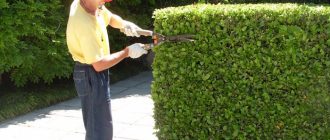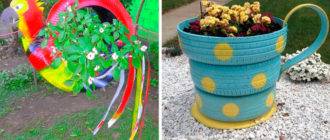In landscape design, a flowering hedge is used along the outer perimeter or when zoning a site. Sometimes such plants mask unsightly buildings, compost pits. Fences from live crops are made of different heights, tiered, emphasize green plantings with colors of flowers. They are selected according to the color scheme, crown height. Landings are formed by pruning, fixed on trellises, sometimes they preserve the natural negligence of wild bushes. Flowering can be selected according to the season.

Spring flowering hedges
For garden fences, you can pick up plants with decorative foliage and early abundant flowering. The bushes fill the air with an amazing aroma and bright colors in late May - early June. Landscaping is maintained until frost.

The table shows the most common deciduous shrubs that do not require constant maintenance. The shrub propagates by root shoots, dividing the bush, cuttings, layering.
| Plant name | Description | Care |
| Weigela | A perennial of the honeysuckle family, 1.5-2 m high. It is moisture-loving, tolerates partial shade well. The leaves are serrate or serrate-serrate. Bell-shaped or funnel-shaped flowers of red, pink, cream, white. | A 3-year-old seedling is transferred to a permanent place in early spring until the buds swell. The bush grows on loams rich in humus. Sanitary pruning is carried out after the snow melts, forming after flowering. For the winter, the soil near the bushes is mulched to warm the roots. |
| Bobovnik (laburnum) | Sprawling bush up to 4 m high. Leaves are oval, trifoliate, slightly pubescent below. The flowers are light or golden yellow, collected in clusters up to 50 cm long. |
For planting, a well-lit area, closed from the north wind, is chosen. The bush loves nutritious soil, responds gratefully to feeding. Rejuvenate plantings by cutting old branches at the root. |
| Elder | Depending on the species, it grows from 2 to 6 m. The leaves are pinnate, pointed, up to 15 cm. The flowers are small, white or colored, forming a dense cap or a fluffy raceme. The berries are small, red or black. Many varieties are poisonous. | Planting time is early spring, late autumn. The bushes are unpretentious to the soil. On loose blooms, abundant, on others - moderate. Every 4 years, the bush is renewed by cutting off old shoots under a "stump". Formative pruning is carried out in late autumn, sanitary in early spring when the buds awaken. |
| Lilac | Multi-stem bush from 2 to 5 m in height. Leaves are whole, drop-shaped or pinnately-divided lanceolate. Flowers, white or lilac with shades of purple or blue, are collected in dense clusters. | Shrubs are planted from July to mid-September in a lighted area. A neutral or slightly acidic soil is fertilized with humus. Top dressing is carried out in the budding phase. Pruning - after flowering. 6-year-old shoots are cut at the root. |
| Chubushnik or garden jasmine | A multi-stemmed, branched shrub with dense wood, from 1.5 to 3 m in height. Leaves are oval or rounded with a pointed tip. Flowers are 5-petaled, collected in small clusters. Fragrant, honey plants. | Rooted young seedlings are planted in a permanent place in early spring before the leaves open. The first year requires regular watering. Top dressing is done no more than once every 5 years, pruning - once every three years. Slices are treated with pitch. |
| Forsythia or forsythia | Olive culture with spreading branches up to 2.5 m high. It blooms profusely during the leafing season. Narrow-petal buds of bright yellow color appear along the entire length of the shoots. In autumn, the narrow pointed leaves turn dark purple or golden (in the Fortuna variety - dark yellow, in the Pestrai - pale yellow, spotted). | For planting, choose lighted or semi-shady areas, the soil is preliminarily limed. When transplanting 3-year-old bushes, part of the crown is removed. Fertilized up to 3 times per season with phosphorus-potassium mineral compositions. In the spring, sanitary pruning is carried out - damaged, frozen and thickening shoots are removed. The plant is formed in early autumn. For the winter, only young bushes are covered: the soil is mulched with a 5 cm layer of humus. |

With age, tall shrubs become bare. For decorativeness, hedges are made multi-tiered.

Frontally planted:
- undersized shrubs that bloom in summer or autumn (Japanese spirea, weigela);
- perennial flowers with decorative greenery (peonies, phloxes, delphinium, goldenrod, rudbeckia, chrysanthemums and others);
- late flowering annuals (asters, gerberas, mirabilis, saffron, datura, gazania).
In landscape design, weigela or bean plants are often combined with lilacs, chubushnik.
Summer flowering hedges
Shrubs that produce flower stalks in July, as a rule, continue to bloom until mid-autumn.

They will become a real decoration of the garden. Perennials are chosen according to the shape of the leaves, the height of the shoots, the color of the buds.
| Plant name | Description | Care |
| Oleander (all parts of the plant are poisonous to humans and animals) | Oleander ordinary - an evergreen shrub up to 4 m high. A fragrant variety - undersized, up to 50 cm. Leaves are leathery, narrow, elongated, dark green. The buds are collected in inflorescences, the color of the petals is pink, all shades of red, crimson, purple. The Indian has yellow, white, red. | Grows in southern regions, in well-lit places. Prefers loose, sandy soil rich in humus. Demanding to watering. Planting is carried out in early spring. In the early days, the bush is shaded. They are fed in the spring-summer period, up to 3 times per season. Every 3-4 years the bush is transplanted, the roots must be pruned. Sanitary pruning is carried out after the leaves appear. For the winter, the bushes are bent down, covered. The earth is mulched with loose material up to 10 cm. In the spring, the bushes are straightened, mulch is removed. |
| Rose border | Medium and low-growing shrubs up to 80 cm high. The buds are medium-sized, terry. Often 2-3 buds grow on one shoot. The thorns are small, often spaced. | For planting a 2-year-old bush, a well-lit, wind-protected place is chosen. The soil is recommended loamy, filled with humus. Loosening is carried out regularly, watered in the absence of rain, fed twice a season. Pruning of bushes is carried out during flowering. For the winter, shelters of boards or branches are built near the bushes. Throw in dry grass. |
| Syrian or garden hibiscus | A frost-resistant perennial of the Malvaceae family grows up to 6 m. The leaves are palmate, slightly corrugated. The buds are single-row or double, yellow, dark red, blue, purple, white, crimson, violet, sometimes with a contrasting center, colored bordering. |
Young plants are planted after recurrent frosts. Drainage up to 10 cm high is laid in the planting pit. Phosphorus-potassium dressing is applied twice a month, nitrogen - during the budding period. Watering is carried out by sprinkling in the evening. Formative pruning - after flowering. In the spring, only dry shoots are removed. Bushes tolerate transplanting well. |
| Hydrangeas are treelike, paniculate, large-leaved | Deciduous shrub with oval pointed leaves and dense flower caps. Treelike grows up to 3 m, the crown is rounded, the caps are uneven, spreading, large, light green, lilac or white in color. Paniculate - standard, up to 1.2 m high. Form pyramidal inflorescences of white, pink, lilac, cream color. Large-leaved forms a sprawling bush, spherical inflorescences, red, blue or pink (the color depends on the level of acidity of the soil). |
They choose lighted or semi-shaded areas that are not prone to flooding.Planting is carried out in early spring or late autumn. Pruning - if necessary, when thickening bushes. Lignified old shoots are removed under the stump. The soil is kept moist. Complex fertilizers are applied twice a season. |
| Action | An evergreen or deciduous perennial of the hydrangea family. Leaves are lanceolate, rounded at the bottom. Shoots are erect or spreading. Flowers are formed in the second year. White buds with a pinkish core are collected in caps or low sultans, inflorescences are formed along the entire length of the shoot. | Planting of young bushes is carried out in the spring, the pits are filled with humus. It is important to leave the root collar on the surface. The place is chosen semi-shady or well-lit. Watered only in dry times. Regular loosening is required, mulching of the trunk circle, feeding once a month, annual pruning in spring and autumn. |
| Tatar honeysuckle | Forms a dense funnel-shaped bush up to 4 m high and 2 m in diameter. The leaves are ovate, below the gray shade. The inflorescences are paired, double. Abundant flowering, throughout the density of the bush. Fruits are gray, up to 2 cm long, inedible. | A young shrub takes root from early spring to late autumn. Resistant to moderate light, partial shade. The soil can be anything except heavy clayey. Formative and sanitary pruning is carried out in early spring, at the same time no more than 1/5 of the crown is removed. Top dressing is applied twice a season. |

Blooming hedges in different styles
Landscape designers select crops for planting according to certain canons:
- for the Russian style, various types of lilac, elderberry, caragan are acceptable;
- Oriental create a lovely colquia, keria and Japanese camellia;
- mediterranean style - a combination of hibiscus, oleander, abelia, bean, tamarisk.
It will take several years to create a full-fledged hedge. After that, she will delight for a long time with bright colors.





